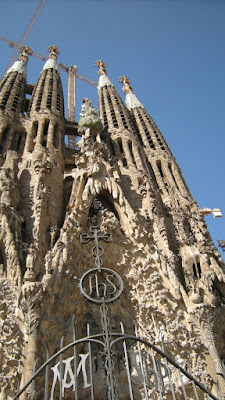Barcelona is called "the most southern city of northern Europe" and is near to France which has had a long standing influence. It's not the place for siestas (sorry, Jean!) and the fiestas that we sometimes imagine Spain to be. It's the capital of a region, Catalunya, which has its own language and shared history. Most signs are translated into three languages--Spanish, Catalan, and English-- and the locals flow between Spanish and Catalan which sounds like a cross between Italian, French and Spanish....It's on the Mediterranean, is a vibrant port city, and has a history that hails from about 230 BC when Mr. Hannibal named it Barca after his father. From those early Carthaginian roots, today, a population of over 1.5 million in Barcelona proper call it home (4 million in the surrounding area). It's big, dense, and has a wonderfully inexpensive transit system that includes subways, trams, and buses; getting around is a breeze (especially if all you have to do is follow Kim and Jean who both love giving directions).
We called "home" a great little apartment that Kim found on the internet with a deck and view of one of Barcelona's main highlights--"La Sagrada Familia". La Sagrada Familia is a church which has more "contemporary" roots in that it was begun in 1882 by a rich publisher who was worried about "the growth of revolutionary ideas". In 1883 he turned the reins of design and building over to 31 year old Antoni Gaudi. Gaudi's is quite the story and if you'd like to know more about him, I suggest you google him. A quick piece of data on him is that as a child he was considered rather "frail" and spent a lot of time outdoors quietly observing nature. His building designs incorporate nature in such a way that was/IS rather astonishing. So much for those worrisome revolutionary ideas... So, if you've never met him, here he is along with some of his work:
La Sagrada Familia
The thing that we found ourselves quite impressed by was watching this actually being built. All of the cathedrals and sights we have seen from antiquity have left us wondering, "wow, what must it have been like to build this?" Perhaps 100 or 200 years from now, others will wonder the same thing.
On 7 June 1926[11] Gaudí was run over by a tram. Because of his ragged attire and empty pockets, many cab drivers refused to pick him up for fear that he would be unable to pay the fare. He was eventually taken to a pauper's hospital in Barcelona. Nobody recognized the injured artist until his friends found him the next day. When they tried to move him into a nicer hospital, Gaudí refused, reportedly saying "I belong here among the poor." He died three days later on 10 June 1926, at age 73, half of Barcelona mourning his death. He was buried in the midst of La Sagrada Família.[10]
Although Gaudí was constantly changing his mind and recreating his blueprints, the only existing copy of his last recorded blue prints were destroyed by the anarchists in 1938 during the Spanish Civil War. This has made it very difficult for his workers to complete the cathedral in the same fashion as Gaudí most likely would have wished. It is for this that Gaudí is known to many as "God's Architect". La Sagrada Família is now being completed, but differences between his work and the new additions can be seen.
Not bad. Not bad at all, Senor Subirachs .
And, one final note of interest:
As of 2007, completion of the Sagrada Familía is planned for 2026. They wish to do this because it is the anniversary of his death. However, this may prove wildly optimistic if the worst fears of many eminent engineers and architects are realized[citation needed]. They have pointed out the structural dangers posed by a tunnel for a TGV-style high-speed rail, which would run within feet of the church’s foundations[12][1]; one might note the precedent of a metro tunnel in Barcelona’s Carmel district that collapsed and destroyed an entire city block on the 1st of February 2005.
uh oh. That won't be good.
















No comments:
Post a Comment